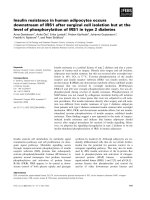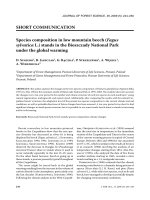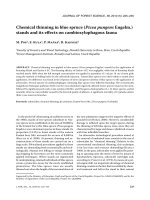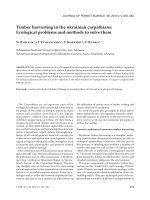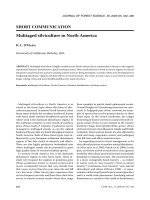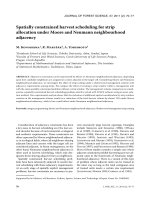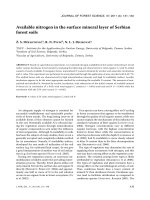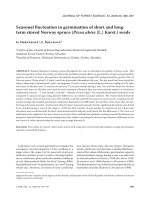Báo cáo lâm nghiệp: " Decay resistance in Dicorynia guianensis Amsh.: analysis of inter-tree and intra-tree variability and relations with wood colour" pptx
Bạn đang xem bản rút gọn của tài liệu. Xem và tải ngay bản đầy đủ của tài liệu tại đây (558.5 KB, 8 trang )
373
Ann. For. Sci. 61 (2004) 373–380
© INRA, EDP Sciences, 2004
DOI: 10.1051/forest:2004030
Original article
Decay resistance in Dicorynia guianensis Amsh.: analysis of inter-tree
and intra-tree variability and relations with wood colour
Nadine AMUSANT
a
*, Jacques BEAUCHENE
b
, Mériem FOURNIER
c
, Gérard JANIN
d
,
Marie-France THEVENON
a
a
CIRAD Forêt/Forest Products Programme, 73 rue JF Breton, 34398 Montpellier Cedex 5, France
b
CIRAD Forêt/Forest Products Programme, BP 701, 97310 French Guiana, France
c
UMR Écologie des forêts de Guyane, CIRAD-ENGREF-INRA, BP 709, 97310 French Guiana, France
d
Universidade de Brasilia, Departamento de Enensharia Florestral, Brasilia D.F., Brazil
(Received 22 November 2003; accepted 9 February 2004)
Abstract – Dicorynia guianensis Amsh. is very widespread in the forests of French Guiana and moreover is the leading species harvested in
this area, but its main defect remains the great variability of wood durability, especially with respect to fungal decay. The aim of this work was
to study this inter- and intra-tree variability in order to identify the parameters responsible for this variation (growth area, height and radial
position) within the tree. The resistance decrease from the outer heartwood to the pith. Measurement of colour variation using the CIELAB (L*,
a*, b*, C*, h*) system was performed at the intra-tree level to highlight the longitudinal and radial gradients of variation. Dicorynia guianensis
becomes less red and dark from the outer to the inner heartwood and from the base to the top. Lastly, variations of colour and durability were
correlated: the wood is less resistant the redder and darker it is.
Dicorynia guianensis / Amazonian wood / wood colour/decay resistance / heartwood / variability
Résumé – Variabilité de la durabilité inter-arbre et intra-arbre de Dicorynia guianensis – et relation avec la couleur. Dicorynia
Guianensis Amsh. est une essence très répandue dans les forêts de Guyane française. C’est l’une des essences les plus exploitées cependant elle
souffre d’un défaut majeur : une grande variabilité de sa durabilité naturelle à l’égard des champignons lignivores (Ascomycètes, Basidiomycètes).
À travers l’étude de la variabilité inter-arbre et intra-arbre nous avons discuté de l’influence de paramètres tels : la localité, la taille de l’arbre,
la hauteur et la position radiale sur la résistance naturelle. Dans une deuxième partie nous avons étudié l’influence de ces mêmes paramètres
sur la mesure de la couleur (système CIELAB) du bois à l’échelle intra-arbre. Nous avons ainsi constaté que le paramètre « position radiale »
était de loin le plus important à l’origine de la variabilité : Dicorynia guianensis est plus résistant du duramen interne vers le duramen externe ;
moins rouge et moins sombre du duramen externe vers le duramen interne. Enfin, nous avons constaté que les variations de couleur et de
durabilité chez Dicorynia guianensis étaient corrélées : le bois est d’autant plus résistant qu’il est moins rouge et plus clair sombre.
bois amazonien / couleur du bois / résistance à la pourriture / duramen / variabilité
1. INTRODUCTION
The variability of natural durability has frequently been
studied with a view to understand and predict the behaviour of
a wood in order to make optimum use of the resource. Dicory-
nia guianensis (basralocus) is of great interest to the local for-
estry industry in French Guiana, and represented 36% of the
extracted volume in 2001 [48, 50]. Many authors [13, 23, 51]
showed that there is a significant variation in the decay suscep-
tibility of this timber, with unfavourable consequences for classi-
fication of its durability. Early studies suggested that Eucalyptus
spp. trees exhibit substantial variations in heartwood decay
resistance within the same species [38, 39, 41]. This fact is usually
attributed to the existence of radial and longitudinal gradients
of decay resistance within the tree [15, 16]. Others factors such
as tree size [7, 34, 41], growth rate [11, 42], and extractives con-
tents in the heartwood [12, 14, 17, 20] help to explain the var-
iations in resistance both between trees and within a single tree.
The objective of this work was therefore to study the varia-
bility of the natural durability of Dicorynia guianensis at intra-
tree and inter-tree level. The relationship between colour and
decay resistance has already been studied [10, 29]. Colour
measurements were therefore performed to determine whether
it was possible to correlate wood colour and durability, and use
colour as an indicator in classifying the biological resistance of
Dicorynia guianensis.
* Corresponding author:
374 N. Amusant et al.
2. MATERIALS AND METHODS
2.1. Tree sampling
2.1.1. For intra-tree variability
Test material was prepared from one tree (Dicorynia guianensis)
especially collected for this work in the Counami Forest in French
Guiana. Two levels of the tree (total height: 35 m) were studied: 3 m
and 15 m above ground. Wooden boards were cut following four radii
positioned perpendicularly and noted A-B-C-D (Fig. 1). For each
board from a radius, three 15 × 25 mm sections (R, T) were cut from
the outer heartwood (Z1), inner heartwood (Z3) and intermediate
heartwood (Z2). Test specimens measuring 15 × 25 × 50 mm (R, T,
L) were cut from each sample obtained.
2.1.2. For inter-tree variability
15 × 25 × 50 mm samples (R, T, L) were cut from the outer and
inner heartwood of 17 trees (Dicorynia guianensis) and one level of
the tree were studied (3 m). All the trees were collected at two sites
in French Guiana: Organabo and Tibourou. The Organabo site is a
white sand forest, typical of the western part of French Guiana. At
Tibourou, the soil is schistose and ferrallitic, typical of central and
eastern French Guiana [2]. The average annual rainfall is also very dif-
ferent: 2600 mm/year and 3700 mm/year at Organabo and Tibourou
respectively [2]. These two sites therefore represent the greatest pos-
sible difference in environmental conditions among the harvested for-
ests of French Guiana. Dicorynia guianensis tree and wood quality is
known to be very different at the two sites: the trees at Tibourou are
larger with a high rate of compression failure. Their silica content and
radial shrinkage are also greater than those of the trees from Organabo
[2]. Table 1 shows the mensuration parameters characteristics of each
sample.
2.2. Decay test
For intra-tree variability, the method used to test natural durability
followed NF-EN 350-1 (AFNOR, 1994) and NF-EN 113 (AFNOR,
1996). The following fungi were selected: two white rots (Coriolus
versicolor and Pycnoporus sanguineus) and a brown rot (Antrodia
sp.). The decay tests were conducted as follows: for each test fungi,
three replicate wood block were used for each height and each radial
position. For inter-tree variability, two tropical fungi were used:
Antrodia sp. (brown rot fungus) and Pycnoporus sanguineus (white
rot fungus). In this case, the decay test was as follows: for each fungi,
ten replicates were used for each tree, each radial position and height.
Beech (Fagus sylvatica) samples of the same dimensions: 15 × 25 ×
50 mm (R, T, L) were used as controls for the virulence of the strains
(ten test blocks for each fungus). The test specimens (two blocks per
flaks) were placed on test specimen supports over the fungal mycelium
and incubated for 16 weeks in a decay chamber (27 °C – 80% relative
humidity). At the end of the test, all the test specimens were removed,
oven dried (103 ± 2 °C) to a constant weight and weighed to determine
mass loss. The classification of natural durability was determined
according to European standard NF-EN 350-1 (AFNOR, 1994). All
the statistical analyses that follow were conducted on the above-
defined mass loss.
2.3. Colour measurement
Colour measurements were performed on the samples used for
intra-tree durability, on which decay tests had been conducted. Colour
was measured every 16 mm along the longitudinal-radial surface and
the longitudinal-tangential surface (six measurements per sample),
using a portable spectrophotometer (MICROFLASH DATACOLOR).
Figure 1. Localisation on stem cross section from which study blocks were taken for the intra-tree level.
Table I. Characteristics of the trees (inter-tree variability).
Tree number
Sapwood
thickness (cm)
Diameter at breast
height (cm)
Organabo site
O11 6.7 51
O12 5.0 62
O14 4.7 68
O17 3.3 73
O21 2.5 78
O29 5.8 65
O30 4.8 67
O31 6.3 60
O35 5.7 55
O36 7.1 59
Tibourou site
T01 9.1 51
T02 7.8 48
T11 6.6 89
T19 2.0 73
T33 8.9 45
T40 3.7 70
T49 1.8 87
Variability of durability and colour of Dicorynia guianensis 375
Illuminant D65 (represents daylight) and 10° CIE were used, param-
eters generally used to measure wood colour [24]. The surface
observed was 59 mm
2
(small opening of 8.7 mm) and the specular
reflection setting was excluded. The reflectance data were collected
at 10 nm intervals over the visible spectrum (from 400 to 700 nm).
The reflectance readings were converted into L*, a*, b*, C* and h*
values, where L* describes lightness along the lightness axis (100 =
white or brightness; 0 = black or darkness) of a colour a* value
describes the redness (a* positive value), or greenness (a* negative
value). Yellowness-blueness is shown by value b*: b* positive for yel-
lowness and b* negative for blueness. The angle h*, hue, can be cal-
culated by using values a* and b*: h* = arctg (b*/a*) in radian, or in
degrees (deg). C* (saturation) can be calculated by the formula C* =
[(a*)
2
+ (b*)
2
]
½
.
Study of colour variability at intra-tree level will be realise accord-
ing to two parameters: (i) radial position: three radial positions were
selected: Z1, Z2 and Z3 (outer, intermediate and inner heartwood);
(ii) height position: 3 m and 15 m above the ground.
2.4. Statistical analysis
The effects at intra-tree level of radial position and height on mass
loss after exposition to fungi were studied by an analysis of variance
(Anova). A second analysis of variance was calculated to evaluate the
effect at inter-tree level of site, tree, radial position and height on mass
loss after exposition to fungi. Values were considered statistically sig-
nificant if P < 0.05. Correlation coefficients were calculated to deter-
mine the relationship between colour parameters and durability at
intra-tree level and between sapwood thickness, diameter and heart-
wood decay resistance at inter-tree level.
3. RESULTS
3.1. Intra-tree variability: effect of radial and height
position
Figure 2 illustrates the intra-tree variability of durability
observed with Dicorynia guianensis.
Using the calculation of the median mass loss rather than the
mean in interpreting the results improves the reproducibility of
the results, and reduces the impact of singular results that can-
not be explained [49]. The median mass losses obtained respec-
tively for each fungus are: 0.1% for Pynoporus sanguineus,
1.7% for Coriolus versicolor and 5.7% for Antrodia sp. Using
the criterion of mass loss (as per standard EN 350-1, AFNOR,
1994) classifies Dicorynia guianensis among durable species.
The median mass loss obtained is between 5%–10% with the
more virulent fungus (Antrodia sp.). Of the three test fungi used,
the brown rot Antrodia sp. proved to be much more destructive
on Dicorynia guianensis, which confirmed the observations of
Déon [13] and Mateejcic [27]. A two factors analysis of variance
(“effect of radial position” and “effect of height”) of the mass
losses due to the more virulent fungi (Antrodia sp. and Coriolus
versicolor) shows that (Fig. 2):
– decay resistance is greater for the outer heartwood than
the inner heartwood. The effect of radial position is significant
for Coriolus versicolor (p = 0.002) and Antrodia sp. (p =0.04) ;
– decay resistance is greater at the top than at the base of the
tree. The effect of height is significant for Antrodia sp. (p =
0.001) but not for Coriolus versicolor (p = 0.43).
3.2. Inter-tree variability: effect of geographical origin,
effect of tree, effect of radial and height position
Figure 3 illustrates the mean mass losses of the seventeen trees
tested with Antrodia sp. and Pycnoporus sanguineus according
locality.
Table II gives the results of correlation R at inter-tree level
(n = 17) between mass losses of the outer and inner heartwood,
tree diameter and sapwood thickness.
Dicorynia guianensis was shown to be more durable to Pyc-
noporus sanguineus than to Antrodia sp. The results obtained
Figure 2. Influence of radial and height position on median mass loss (Coriolus versicolor and Antrodia sp.).
Figure 3. Inter-tree mean mass loss due to Antrodia sp. and Pycnop-
orus sanguineus according locality.
376 N. Amusant et al.
here are comparable to those of the study on intra-tree varia-
bility; but Antrodia sp. is more destructive on this range of sam-
ples than these from the intra tree study. This sample of trees
is not very durable with regard to brown rot but it is with regard
to white rot (Fig. 3). Radial position effect is significant in a
two factors ANOVA “site × radial position” (p = 0.01) and in
a two factors ANOVA “tree × radial position” (p = 0.002) for
samples exposed to the more destructive fungus Antrodia sp.
So, outer heartwood is more resistant than the inner one. In both
ANOVA, other factors (“site” and “tree”) are not significant
with no interaction (P > 0.2). Durability of the outer heartwood
is slightly correlated with the morphological characteristics of
the tree (Tab. II): R = –0.37 with sapwood thickness and R = 0.44
with tree diameter. Thus the greater the diameter of the tree, the
thinner the sapwood and the less durable is the wood.
3.3. Possible use of colour as an indicator of durability
– study of intra-tree colour
Table III shows the mean, standard variation and coefficient
of variation of colour parameters. The lightness index (L*),
whose possible range is from 0 to 100 in the CIELAB colour
system, ranges approximately from 44 to 63 (Tab. III). The val-
ues for a* range approximately from 11 to 17 and b* from 15
to 26.
Figure 4 gives relation between L* parameter and h* param-
eter and Figures 5, 6 and 7 illustrate the intra-tree variability
of colour parameters.
There is a good correlation between L* and h* (Fig. 4), and
the latter is an important parameter for interpretation of colour.
Lightness (L*) and hue angle (h*) decrease and C* (saturation)
increases (Figs. 5, 6 and 7) as the distance closer to the outer-
most heartwood diminishes. For L*, C* and h* parameters,
radial position and height effect are significant in a two factors
ANOVA “radial position × height” (p < 0.0001). The variation
in h* measured between the outer and the inner heartwood is
visible to the human eye. This means that the colour of the wood
becomes lighter and less red near the pith and lightness and hue
increase from the base to the top, so the wood is less red and
lighter in the upper part of the tree.
Table II. Correlation between diameter, sapwood thickness and mass
loss (outer and inner heartwood) – exposition to Antrodia sp. (n = 68).
Mean loss –
outer heartwood
Mean mass loss –
inner heartwood
Tree
diameter
Mean mass loss –
outer heartwood
1
Mean mass loss –
inner heartwood
0.04
(Pr > 0.80)
1
Tree diameter 0.44
(Pr = 0.07)
0.08
(Pr = 0.76)
1
Sapwood thickness –0.37
(Pr = 0.14)
0.01
(Pr = 0.96)
–0.65
(Pr = 0.004)
Figure 4. Relation between L* and h* colour parameters.
Figure 5. Variation in mean L* with radial position and height.
Figure 6. Variation in mean C* with radial position and height.
Table III. Wood specimen colour in the CIELAB colour system (n = 334).
Data L* a* b* C* h* (degree)
Mean 56.2 15.3 23.5 28.1 56.8
Standard variation 2.1 0.6 1.0 1.0 1.1
Coefficient of variation (%) 4 4 4 1 2
Variability of durability and colour of Dicorynia guianensis 377
Figures 8 and 9 give respectively reflectance of Z1 (outer
heartwood) and Z3 (inner heartwood and differences in reflect-
ance between different zone curves.
The absorption decreases with wavelength. It is greater in
the outer heartwood (Fig. 8). The values for the difference in
reflectance (DR %) between Z2 (intermediate zone) and Z3
(inner heartwood), and Z1 (outer heartwood) and Z3 (inner
heartwood) show the same maximum DR% absorbency at 590 nm
(Fig. 9). The colour of the different zones is connected with the
total difference in the concentration of organic materials, which
absorb the energy of each wavelength over the visible spectrum
(400–700 nm). For these reasons, the absorbency in the inner
heartwood (Z3) would give the darkest colour but with the same
distribution of absorbed light (Fig. 9). The curves of reflectance
are parallel but there is a difference between both peaks at 590 nm.
3.4. Correlation between natural durability and colour
parameters
Tables IV and V show results of correlation R at intra-tree
level (2 × n = 48) between mass losses and colour parameters
(L*, a*, b*, C*, h*) with both fungi: Coriolus versicolor and
Antrodia sp.
Considering the values measured on each sample (from the same
tree), there is a correlation between colour parameters L*, a* and
h* and decay resistance (Tabs. IV and V) with Coriolus versicolor
exposition but not with Antrodia sp. In the case of Coriolus ver-
sicolor, the wood is more durable when it is darker and redder.
4. DISCUSSION
4.1. Durability
Dicorynia guianensis shows important variations in natural
durability from one individual to another. The results show that
Dicorynia guianensis is much more resistant to white rot than
to brown rot. This fact may be explained by the idea put forward
by other authors [31, 33, 34], who thought that extractives
present in the heartwood may not have the same effect on both
types of fungi. For a large number of species, it is widely rec-
ognised that natural durability varies depending on the height
and on the radial section of the tree [17, 43]. The intra-tree var-
iability of natural durability was discussed by Rudman in a
series of articles entitled “The causes of natural durability in
timber” [35, 37–39, 41] and more recently by other authors such
as Viitanen [50] and Hirmke [21]. The behaviour of Dicorynia
guianensis tallies with the results obtained with other tropical and
Figure 7. Variation in mean h* (deg) with radial position and height.
Figure 8. Reflectance of Z1 (outer heartwood) and Z3 (inner heart-
wood).
Table IV. Correlation between mass loss and colour parameters –
exposure to Coriolus versicolor.
L* a* b* C*) h* (deg)
Mass loss 0.30
(0.03)
–0.44
(0.0017)
0.05
(0.74)
–0.11
(0.43)
0.42
(0.028)
Threshold (*) (**) (n.s.) (n.s.) (**)
Table V. Correlation between mass loss and colour parameters –
exposure to Antrodia sp.
L* a* b* C*) h* (deg)
Mass loss –0.06
(0.70)
0.14
(0.36)
–0.08
(0.58)
–0.004
(0.97)
–0.19
(0.22)
Threshold (n.s.) (n.s.) (n.s.) (n.s.) (n.s.)
Figure 9. Differences (DR %) in reflectance between zone curves:
(a) Z1 outer – Z3 inner and (b) Z2 intermediate – Z3 inner.
378 N. Amusant et al.
temperate species. The intra-tree variation in durability in Dicory-
nia guianensis explains a substantial part of the variability. The
large radial variation in resistance to decay shown by many
trees is especially noteworthy: the outer heartwood is more
durable, with a decrease in durability towards the pith. These
results are confirmed by those presented by Déon [13] and Thiel
[47] who studied the same species. Decay resistance increases
from the base to the top of the tree. However, they do not tally
with those of Reis [32], who studied wood species from south-
eastern Brazil or with those of Zabel [53]. Nevertheless, Hart
[18] reported that height effect is not systematic.
Lastly, there is an interesting correlation between sapwood
thickness or tree diameter and the durability of the outer heart-
wood. It is unusual to find a correlation between tree diameter
and the durability of the outer heartwood only [6]. As size is
usually considered as an indicator of tree age in tropical trees,
one could expected a closer correlation with inner heartwood
durability, since it integrates time-dependent processes. How-
ever, another result of this study is that tree size is connected
to an initial durability existing before any extractives ageing
process. As there is strong negative correlation between tree
diameter and sapwood thickness, it would be interesting to per-
form further studies with trees of the same age or diameter, to
observe a possible intrinsic effect of sapwood thickness linked
to duraminisation and growth process.
4.2. Colorimetry
Dicorynia guianensis colour in this study was lighter and
greyer than that obtained by Nishino [30] for the same species
(L = 39; a = 12; b = 16). This may be explained by the storage
conditions: in our study, the wood samples were protected from
light during conditioning, as colour is not a stable parameter in
time and can be modified by humidity and exposure to light [8].
Our measurements characterised the colour of wood just after
sawing (short exposition to light) and drying (12% moisture
content). The most important factor influencing the colour of
Dicorynia guianensis was found to be radial position, with the
wood becoming less red and lighter near the pith. Finally, our
Dicorynia guianensis trees did not behave like European hard-
wood species such as oak, in which the inner heartwood is redder
and darker [22]; nevertheless, this behaviour is not systematic
for hardwood species [5]. Colour parameters L*, C* and h* are
also influenced by height: the colour becomes less red and lighter
in the upper part of the tree. Some researchers have supple-
mented their studies by monitoring extractives contents from
the outer to the inner heartwood, and they showed that they were
strongly correlated: quantitative and qualitative extractives con-
tents in the wood influence colour parameters [4]. When stud-
ying difference in reflectance between difference zones (inner
and outer heartwood), it is important to note the absence of a
more or less marked peak. So the differences of colour meas-
urements observed in these zones could be explained by different
concentration of extractives between different parts of heart-
wood rather than the presence of different molecules which
absorbed at characteristic wavelength. Thus the reflectance
curves are of great interest in understanding the colour of the
wood and its relation with extractives content [5]. However, a
considerable part of the variability of wood colour cannot be
explained.
4.3. Relation between colour and durability
Both colour parameters and decay resistance vary from the
inner to the outer heartwood. The colour of the heartwood sug-
gests that the compounds in the wood absorb some light wave-
lengths. However, not all compounds have an effect against
fungi, and the occurrence of a dark colour cannot automatically
be linked with the presence of the active molecules in biological
resistance. It is necessary to study the presence and the chemical
nature of the molecules more closely. The function of such
compounds in terms of colour cannot simply be associated with
natural resistance. However, there may be a correlation between
colour and natural durability: biological resistance and wood
colour are directly connected with quantitative and qualitative
extractives composition [24, 29, 40]. The effects of extractives
on wood colour have been studied by several authors [3, 14,
28, 29]. Extracting extractives using suitable solvents modifies
wood colour. In the same way, many authors have underlined
the direct relationship between durability and extractives [1, 9,
19, 25, 33, 44, 45]. They have shown that extractives play a key
role in the biological resistance of many species [26, 36, 46, 52].
5. CONCLUSION
Our results confirm that the natural durability of Dicorynia
guianensis varies widely and that it is important to control it
because consequences are important for users. They support the
following specific conclusions:
1.At intra-tree level, colour parameters are linked with
heartwood resistance: the darker and redder the wood, the more
resistant it is.
2.Decay resistance in the outer heartwood is related to tree
diameter and sapwood thickness: the thinner the sapwood, the
greater the tree diameter and the lower the decay resistance.
3.Colour is related to height and radial position in the tree:
the wood is darker and redder in the outer heartwood and at the
base of the tree.
4.Decay resistance decreases from the outer to the inner
heartwood. Variations from the base to the top of the trees are
less systematic.
5. There is no effect of locality although the two forest studied
are extremely different natural conditions in French Guiana.
All this information can help operators to choose the best
wood for the intended end use. This is the fit-for-purpose
approach. The influence of the site on natural durability is less
important. However, the outer heartwood of medium-diameter
trees is more resistant. This information is useful for optimising
the period of rotation for forest harvesting: there is a trade-off
between yield (big diameter) and quality (natural durability).
Moreover, in sawmills, grading of planks for natural durability
should take into account log size and radial position inside the
log. Grading logs according to geographical criteria before
sawing seems less efficient.
Acknowledgements: The authors are extremely grateful to CNES
(Centre National d’Études Spatiales), which supported the study and
the PhD. Our thanks also go to Christine Baudassé, Alba Zaremsky
and Sang Song (CIRAD Forest Products Programme, Montpellier)
Variability of durability and colour of Dicorynia guianensis 379
and Patrick Martin and Koese Soepe, Eli Baltus (CIRAD Forest Prod-
ucts Programme, French Guiana), and Olivier Dumonceau (LMGC-
Montpellier).
REFERENCES
[1 Anagnost S.E., Smith W.B., Comparative decay of heartwood and
sapwood of Red Maple, Wood Fiber Sci. 29 (1997) 189–194.
[2] Bonjour I., Variabilité de la qualité des bois d’une essence guyanaise :
l’Angélique Dicorynia guianensis Amsh., Thèse ENGREF, 1996,
314 p.
[3] Burtin P., Le déterminisme de la couleur du bois de Chêne. Étude
sur les relations entre la couleur et des propriétés physiques, chimi-
ques et anatomiques ainsi que des caractéristiques de croissance,
Thèse de 3
e
cycle en sciences du bois, ENGREF Nancy, 1994, 243 p.
[4] Burtin P., Jay-Allemand C., Charpentier J., Janin G., Natural wood
colouring process in Juglans sp. (J. nigra, J. regia and hybrid J. nigra
23 × J. regia) depends on native phenolic compounds accumulated
in the transition zone between sapwood and heartwood, Trees 12
(1998) 258–264.
[5] Burtin P., Jay-Allemand C., Janin G., Relation entre les composés
phénoliques solubles du bois de noyer (Juglans regia) et sa couleur,
4
e
colloque des Sciences et Industries du Bois Nancy, 1996, pp. 107–
114.
[6] Carrodus B.B., Variability in the proportion of heartwood formed
in woody stems, New Phytol. 71 (1972) 713–718.
[7] Cartwright K.S.G., The variability in resistance to decay of the hear-
twood of home-grown western red cedar (Thuja plicata D. Don) and
its relation to position in the log, Forestry 15 (1941) 65–75.
[8] Chang S.T., Wang S., Cheng S.S., Environmental effects on the
colour of Sugi (Cryptomeria japonica D. Don) heartwood, J. Wood
Sci. 46 (2000) 390–394.
[9] Chang S.T., Wang J.H., Wu C.L., Chen P.F., Kuo Y.H., Comparai-
son of the antifungal activity of cadinane skeletal sesquiterpenoïd
from Taiwania (Tawania Crypromerioides Hayara) heartwood,
Holzforschung 54 (2000) 241–245.
[10] Da Costa E.W.B., Rudman P., Deverall F.J., Inter-tree variation in
decay resistance of Karri (Eucalyptus diversicolor F. Muell) as rela-
ted to colour, density and extractives content, J. Inst. Wood Sci. 10
(1962) 48–55.
[11] Da Costa E.W.B., Rudman P., Gay F.J., Investigations on the dura-
bility of Tectona grandis, Empire Forestry Review 37 (1958) 291–
298.
[12] Da Costa E.W.B., Rudman P., Gay J.F., Relationship of growth rate
and related factors to durability in Tectona Grandis, Empire Forestry
Review 40 (1961) 308–319.
[13] Déon G., A propos de la durabilité naturelle de l’Angélique (Dico-
rynia guianensis Amsh), CTFT – Note technique 13, 1980, 26 p.
[14]Dumonceau O., Utilisation de petits bois naturellement durables
dans des usages extérieurs (aire de jeux, mobilier urbain ) en subs-
titution aux bois traités par des pesticides comme les solutions cuivre-
chrome-arsenic, Thèse de 3
e
cycle en sciences du bois, Université
de Montpellier II, 2001, 210 p.
[15] Freitag C.M., Morrell J., Durability of a changing Western Redcedar
resource, Wood Fiber Sci. 33 (2000) 69–75.
[16] Gartner B.L., Morell J.J., Freitag C.M., Spicer R., Heartwood decay
resistance by vertical and radial position in Douglas-fir trees from
a young stand, Can. J. For. Res. 29 (1999) 1993–1996.
[17] Gominho J., Figueira J., Rodrigues and Pereira H., Within-tree varia-
tion of heartwood extractives and wood density in the Eucalyptus
hybrid Urograndis (Eucalyptus grandis × E. Urophylla), Wood
Fiber Sci. 33 (2001) 3–8.
[18] Hart J.H., The role of wood exudates and extractives in protecting
wood from decay, Chap. 9.2, Rowe J.W. (Ed.), 1981, pp. 861–881.
[19] Hillis W.E., Distribution, properties and formation of some wood
extractives, Wood Sci. Technol. (1971) 273–289.
[20] Highley T.L., Scheffer T.C., Natural decay resistance of 30 peruvian
woods, USDA Forest Service Research Paper, FPL 143 (1970) 1–5.
[21] Hirmke M., Messner K., Teischinger A., Fellner J., Wimmer R.,
Influence of felling time on natural durability of Norway Spruce
(Picea abies (L.) Karst.), Document IRG WP No 98–10250, 1998,
pp. 1–7.
[22] Janin G., Klumpers J., Ducci F., Verracini A., Sevrin E., La couleur
du bois des feuillus précieux : Chênes, Noyers, Alisiers, Lignasylva,
1990, pp. 348–355.
[23] Kukachka B.F., Angelique. Revised November, U.S. Products Lab-
oratory Report 1787, 1958, 8 p.
[24] Klumpers J., Le déterminisme de la couleur du bois de Chêne : Étude
sur les relations entre la couleur et des propriétés physiques, chimi-
ques et anatomiques ainsi que des caractéristiques de croissance,
Thèse de 3
e
cycle en sciences du bois, ENGREF Nancy, 1994, 195 p.
[25] Laks P.E., Wood preservation as trees do it, Scott. For. 45 (1991)
275–284.
[26] Laks P.E., McKaig P.A., Flavonoïd biocides: wood preservatives
based on condensed tannins, Holzforschung 42 (1988) 299–306.
[27] Mateejcic B.A., Dicorynia guianensis Amsh. A monograph, Ligna
orbis – Serie Internationalis – Royal Tropical Institute Amsterdam,
1974.
[28] Mosedale J.R., Charrier B, Janin G., Genetic control of wood colour
density and heartwood ellagitanin concentration in European Oak
(Quercus petraea and Q. robur), Forestry 69 (1996) 11–124.
[29] Nelson N.D., Heather W.A., Wood color, basic density, and decay
resistance in heartwood of fast grown Eucalyptus grandis Hill ex
Maiden, Holzforschung 26 (1972) 54–60.
[30] Nishino Y., Janin G., Chanson B., Détienne P., Gril J., Thibaut B.,
Colorimetry of wood specimens from French Guiana, J. Wood Sci.
44 (1998) 3–8.
[31] Panayotov P., Roussanov H., Yankoulova S., 3rd ICFWST 97, Fun-
gus resistance of wood species common in Bulgaria, Proceeding
book of the 3rd ICFWST, 1997, pp. 164–167.
[32] Reis M.S., Variation in decay resistance of four wood species from
Southeastern Brazil, Holzforschung 27 (1973) 103–111.
[33] Rudman P., The causes of natural durability in timber. Pt. VII, The
causes of decay resistance in Teak (Tectona grandis L.f), Holzfors-
chung 15 (1961) 151–155.
[34] Rudman P., The causes of natural durability in timber. Pt. IX, The
antifungal activity of heartwood extractives in a wood substrate,
Holzforschung 16 (1962) 74–77.
[35] Rudman P., The cause of natural durability in timber. Pt. XII, The
deterioration in antifungal activity of heartwood extractives during
the life of trees of Eucalyptus marginata Sm., Holzforschung 17
(1963) 86–89.
[36] Rudman P., The causes of natural durability in timber. Pt. XI, Some
tests on the fungi toxicity of wood extractives and related com-
pounds, Holzforschung 17 (1963) 54–57.
[37] Rudman P., The causes of natural durability in timber. Pt. XVI, The
causes of variation in decay resistance in Jarrah (Eucalyptus margi-
nata Sm.), Holzforschung 18 (1964) 172–177.
[38] Rudman P., The causes of natural durability in timber, Pt. XIX,
Ageing of Eucalyptus heartwoods and its effects on decay resistance,
Holzforschung 19 (1965) 190–195.
[39] Rudman P., Da Costa E.W.B., Variation in extractives content and
decay resistance in the heartwood of Tectona grandis L.f., J. Inst.
Wood Sci. 3 (1959) 33–42.
[40] Rudman P., Da Costa E.W.B., The causes of natural durability in tim-
ber, Pt. IV, Variation in the role of toxic extractives in the resistance
of durable Eucalyptus to decay, Holzforschung 15 (1961) 10–15.
[41] Rudman P., Da Costa E.W.B., Gay J.F., Wood quality in plus trees
of Teak (Tectona grandis L.F.). An assessment of decay and termite
resistance, Sylvae Genet. 16 (1967) 102–105.
[42] Rudman P., Gay J.F., The causes of natural durability in timber. Pt.
XX, The causes of variation in the termite resistance of Jarrah (Euca-
lyptus marginata Sm.), Holzforschung 21 (1967) 21–23.
380 N. Amusant et al.
[43] Scheffer T.C., Cowling E.B., Natural resistance of wood to micro-
bial deterioration, Annu. Rev. Phytopathol. 4 (1966) 147–170.
[44] Schultz T.P., Harms W.B., Fisher T.H., Mc Murtrey K.D., Minn J.,
Nicholas D.D., Durability of Angiosperm heartwood: the impor-
tance of extractives, Holzforschung 49 (1995) 29–34.
[45] Smith A.L., Campbell C.L., Diwakar M.P., Hanover J.W., Miller
R.O., Extracts from Black Locust heartwood as wood preservatives:
A comparison of the methanol extract with pentachlorophenol and
chromated copper arsenate, Holzforschung 43 (1989) 421–423.
[46] Suttie E.D., Orsler R.J., The influence of the natural extractives of
Opepe (Nauclea diderrichii) and African Padauk (Pterocarpus
soyauxii) timbers on their durability, Document IRG WP No 96-
30098, 1996, pp. 1–15.
[47] Thiel G., Compte rendu des essais effectués sur douze plateaux
d’Angélique envoyés par Monsieur Audiard, CTFT, 1982, 21 p.
[48] Vallet A., La filière bois de Guyane - Stratégie de développement.
Cabinet Sagital, Cayenne, 2002, 95 p.
[49] Van Acker J., Stevens M., Increased biological durability differs for
traditional wood preservation and new non-biocidal systems (NBS),
Document IRG WP No. 00-20212, 2000, pp. 1–11.
[50] Viitanen H., Ritschkoff A., Moisture requirements and wood degra-
dation of Pine and Spruce wood by some basidiomycetes – fungi,
Document IRG WP No. 1406, 1989, pp. 1–8.
[51] Wangaard F.F., Muschler A.F., Properties and uses of tropical
woods., University School of Forestry, Yale University, Newhaven,
Connecticut, 1952.
[52] Yatagai M., Takahashi M., Tropical wood extractives effects on
durability, paint curing, and pulp sheet resin spotting, J. Inst. Wood
Sci. 12 (1980) 176–181.
[53] Zabel R.A., Morell J.J., Wood microbiology – Decay and its pre-
vention, Press Academic Inc, 1992.
STANDARDS
AFNOR (1992): Norme NF EN 350-1 Durability of wood ad wood-
based products – Natural durability of solid wood – part 1: Guide to
principles testing and classification of the natural durability of wood.
AFNOR (1994): Norme NF EN 350-1 Durability of wood ad wood-
based products – Natural durability of solid wood – part 1: Guide to
principles testing and classification of the natural durability of wood.
AFNOR (1996): Norme NF-EN 113 Wood preservatives – Test
method for determining the protective effectivness against wood
destroying basidiomycetes – Determination of the toxic values.
To access this journal online:
www.edpsciences.org
